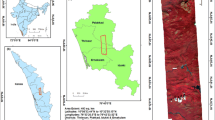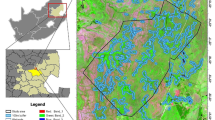Abstract
Feature selection methods play an important role in Hyperspectral Remote Sensing applications, especially in classification. This paper proposed a new Feature selection strategy for Hyperspectral dataset. This strategy was designed to help refine vegetation classification of 4 categories with 13 species vegetation which are the most common species in central China. An ASD field spectrometer (Analytical Spectral Device) was used to collect spectrum information of plant leaves from each species through 400 nm to 900 nm with 1 nm spectral resolution. Firstly, correlation between the physical/chemical characteristics of the leaves and the separability of each vegetation species was tested. Then, two feature selection methods, spectral angle and spectral distance, and the feature parameters extracted from spectral curves (FPESC) were used to build the feature space which would be the input space for the classifiers. At last, two linear classifiers, mahalanobis distance (MDC), and fisher linear discriminate analysis (FLDA), and a quadratic classifier, maximum likelihood (MLC), were used for vegetation species refine classification. The results showed that (1) there were no significant differences among 13 species on the leaf dry weight (physical parameter) and leaf chlorophyll content (chemical parameter); (2) FPESC of 13 species have distinctive differences and could be ideal features to discriminate these species; (3) The linear classifiers, MDC and FLDA, have better classification results in the experiments compared to the quadratic classifier MLC, where MDC has the highest classification accuracy which is above 96.2 %.




Similar content being viewed by others
References
Bajorski, P. (2011). Statistical inference in PCA for hyperspectral images. IEEE Journal of Selected Topics in Signal Processing, 5(3), 438–445.
Bishop, C. M. (2006). Pattern recognition and machine learning. Printed in Singapore.
Chen, E. X., Li, Z. Y., Tan, B. X., Liang, Y. Z., & Zhang, Z. L. (2007). Validation of statistic based forest types classification methods using hyerspectral data. Scientia Silvae Sinicae, 43(1), 84–89.
Clark, M. L., Roberts, D. A., & Clark, D. B. (2005). Hyperspectral discrimination of tropical rain forest tree species at leaf to crown scales. Remote Sensing of Environment, 96(3–4), 375–398.
Cochrane, M. A. (2000). Using vegetation reflectance variability for species level classification of hyperspectral data. International Journal of Remote Sensing, 21(10), 2075–2087.
Gong, P., Pu, R. L., & Yu, B. (1998). Conifer species recognition with seasonal hyperspectral data. Journal of Remote Sensing, 2(3), 211–217.
Goodenough, D. G., Niemann, A., Dyk, K. O., Pearlman, J. S., Chen, H., Han, T., et al. (2003). Processing hyperion and ALI for forest classification. IEEE Transactions on Geoscience and Remote Sensing, 41(6), 1321–1331.
Hestir, E. L., Khanna, S., Andrew, M. E., Santos, M. J., Viers, J. H., Greenberg, J. A., et al. (2008). Identification of invasive vegetation using hyperspectral remote sensing in the California Delta ecosystem. Remote Sensing of Environment, 112(11), 4034–4047.
Hoffbeck, J. P., & Landgrebe, D. A. (1996). Covariance matrix estimation and classification with limited training data. IEEE Transactions on Pattern Analysis and Machine Intelligence, 18(7), 763–767.
Huang, C. Y., & Asner, G. P. (2009). Applications of remote sensing to alien invasive plant studies. Sensors, 9, 4869–4889.
Ismail, M. H., & Jusoff, K. (2008). Satellite data classification accuracy assessment based from a reference data set. International Journal of Computer and Information Science Engineering, 2, 96–102.
Jon, A. B., Martino, P., & Kolbeinn, A. (2003). Classification and feature extraction for remote sensing images from urban areas based on morphological transformations. IEEE Transactions on Geoscience and Remote Sensing, 41(9), 1940–1949.
Jose, P. H., & David, A. L. (1996). Classification of remote sensing image having high spectral resolution. Remote Sensing of Environment, 57, 119–126.
Jouan, A. (2007). FastICA (MNF) for feature generation in hyperspectral imagery. 10th International Conference on Information Fusion, 1–8.
Kalacska, M., Bohlman, S., Sanchez-Azofeifa, G. A., Castro-Esau, K., & Caelli, T. (2007). Hyperspectral discrimination of tropical dry forest lianas and trees: comparative data reduction approaches at the leaf and canopy levels. Remote Sensing of Environment, 109(4), 406–415.
Kozoderov, V. V., & Dmitriev, E. V. (2011). Remote sensing of soils and vegetation: quantitative parameters retrieval using pattern-recognition techniques and forest stand structure assessment. International Journal of Remote Sensing, 32(20), 5699–5717.
Lu, D. (2005). Integration of vegetation inventory data and Landsat TM image for vegetation classification in the western Brazilian Amazon. Forest Ecology and Management, 213, 369–383.
Lu, D. S., Batistella, M., Moran, E., & de Miranda, E. E. (2008). A comparative study of Landsat TM and SPOT HRG images for vegetation classification in the Brazilian Amazon. Photogrammetric Engineering and Remote Sensing, 74(3), 311–321.
Martin, M. E. (1998). Determining forest species composition using high spectral resolution remote sensing data. Remote Sensing of Environment, 65, 249–254.
Onojeghuo, A. O., & Blackburn, G. A. (2011). Mapping reedbed habitats using texture-based classification of QuickBird imagery. International Journal of Remote Sensing, 32(23), 8121–8138.
Perumal, K., & Bhaskaran, R. (2010). Supervised classification performance of multispectral images. Journal of Computing, 2(2), 124–129.
Pudil, P., Novevicova, J., & Kittler, J. (1994). Floating search methods in feature selection. Pattern Recognition Letters, 15(11), 1119–1125.
Serpico, S. B., & Bruzzone, L. (2001). A new search algorithm for feature selection in hyperspectral remote sensing images. IEEE Transactions on Geoscience and Remote Sensing, 39(7), 1360–1367.
Smith, K. L., Steven, M. D., & Colls, J. J. (2004). Use of hyperspectral derivative ratios in the red-edge region to identify plant stress responses to gas leaks. Remote Sensing of Environment, 92, 207–217.
Thenkabail, P. S., Enclona, E. A., Ashton, M. S., & Meer, B. V. D. (2004). Accuracy assessments of hyperspectral waveband performance for vegetation analysis applications. Remote Sensing of Environment, 91(3–4), 354–376.
Vaiphasa, C., Ongsomwang, S., Vaiphasa, T., & Skidmore, A. K. (2005). Tropical mangrove species discrimination using hyperspectral data: a laboratory study. Estuarine, Coastal and Shelf Science, 65, 371–379.
Vaiphasa, C., Skidmore, A. K., Boer, W. F., & Vaiphasa, T. (2007). A hyperspectral band selector for plant species discrimination. ISPRS Journal of Photogrammetry and Remote Sensing, 62, 225–235.
Wang, L., Ji, H. B., & Shi, Y. (2011). Face recognition using maximum local fisher discriminant analysis, 18th IEEE International Conference on Image Processing, 1737–1740.
Xie, Y., Sha, Z., & Yu, M. (2008). Remote sensing imagery in vegetation mapping: a review. Journal of Plant Ecology, 1, 9–23.
Zarco-Tejada, P. J., Pushnik, J. C., Dobrowski, S., & Ustin, S. L. (2003). Steady state chlorophyll a fluorescence detection from canopy derivative reflectance and double-peak red-edge effects. Remote Sensing of Environment, 84, 283–294.
Zaw Htun, N., Mizoue, N., & Yoshida, S. (2011). Classifying tropical deciduous vegetation: a comparison of multiple approaches in Popa Mountain Park, Myanmar. International Journal of Remote Sensing, 32(24), 8935–8948.
Zhang, J., Rivard, B., Sánchez-Azofeifa, A., & Castro-Esau, K. (2006). Intra-and inter-class spectral variability of tropical tree species at La Selva, Costa Rica: implications for species identification using HYDICE imagery. Remote Sensing of Environment, 105(2), 129–141.
Zhao, D., Huang, L., Li, J., & Qi, J. (2007). A comparative analysis of broadband and narrowband derived vegetation indices in predicting LAI and CCD of a cotton canopy. ISPRS Journal of Photogrammetry and Remote Sensing, 62(1), 25–33.
Acknowledgments
This research is supported by National High Technology Research and Development Program of China (863 Program)(grand No. 2012AA12A304 and 2013AA102401). Additional funding and supporting is also provided by the Fundamental Research Funds for the Central Universities (grand No.2012ZYTS037).
Author information
Authors and Affiliations
Corresponding author
About this article
Cite this article
Dian, Y., Fang, S., Le, Y. et al. Comparison of the Different Classifiers in Vegetation Species Discrimination Using Hyperspectral Reflectance Data. J Indian Soc Remote Sens 42, 61–72 (2014). https://doi.org/10.1007/s12524-013-0309-9
Received:
Accepted:
Published:
Issue Date:
DOI: https://doi.org/10.1007/s12524-013-0309-9




